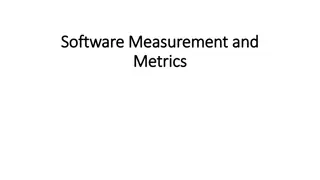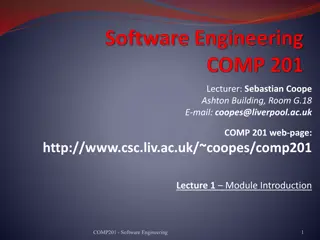Effective Software Project Planning for Strategic Decision-Making
Software project planning involves making key decisions under limited resources throughout the project lifecycle. Analyzing risks, uncertainties, and uncertainties allows for better decision-making, often through buying information like prototyping. Project estimation is a crucial initial step that requires experience, historical data, and careful consideration of various uncertainties. Regular updates and defining best and worst-case scenarios are essential in the evolutionary process models for project estimation.
Download Presentation

Please find below an Image/Link to download the presentation.
The content on the website is provided AS IS for your information and personal use only. It may not be sold, licensed, or shared on other websites without obtaining consent from the author.If you encounter any issues during the download, it is possible that the publisher has removed the file from their server.
You are allowed to download the files provided on this website for personal or commercial use, subject to the condition that they are used lawfully. All files are the property of their respective owners.
The content on the website is provided AS IS for your information and personal use only. It may not be sold, licensed, or shared on other websites without obtaining consent from the author.
E N D
Presentation Transcript
SWE economics analysis (Boehm, 84): throughout the software lifecycle, there are many decision situations involving limited resources
Examples feasibility phase how much should we invest in analyses? plans and requirements phase how rigorously should we specify requirements? design phase: should we use existing sw which does not completely meet the requriements? test phase: how much testing is enough?
Analyzing risk and uncertainty can apply basic micro economic analysis to these questions in sw engineering, must make decisions under conditions of uncertainty can reduce uncertainty, and therefore make better decisions, by buying information e.g. prototyping is a way of buying information to reduce uncertainty about risky functionality
Question must ask: How much information-buying is enough?
Project Planning sw project management process begins with project planning objective of sw project planning - to provide a framework for manager to make reasonable estimates of resources, costs and schedules
project estimation first step in project planning estimate resources, cost, and schedule for sw development project requires experience and access to historical information
project estimation estimation is risky business - lots of uncertainty due to: project complexity project size degree of structural uncertainty - degree to which requirements are solidified availability of historical information risk - measured by degree of uncertainty in quantitative estimates
project estimation evolutionary process models - iterative view of development possible to revise the estimate estimates made at beginning of sw project should be updated regularly estimates should define best case and worst case
Activities associated with project planning Software scope resources project estimation decomposition
1. software scope want to establish a project scope that is unambiguous and understandable at management and technical levels describes: function performance constraints interfaces reliability
2. resources must estimate resources required to accomplish the development effort fig. 5.2 development resources pyramid
a. hw and sw tools foundation of resources pyramid, provides infrastructure to support development sw engineering environment must prescribe the time-frame required for hw and sw verify that these resources will be available
b. reusable sw components next level, can reduce development costs reuse considerations often ignored can greatly reduce development time
c. people - top of pyramid select skills needed
each resource specified with 4 characteristics 1. description of resource 2. statement of availability 3. chronological time resource will be needed 4. duration of time resource used
3. project estimation cost estimates must be provided up front but... the longer we wait, the more we know, and the better our estimates
a. use of decomposition techniques: divide and conquer approach decompose project into major functions and related swe activities cost and effort estimates performed in stepwise fashion
b. empirical estimation models can complement decomposition techniques or used alone model is based on historical data examples: LOC, FP SW cost estimation relies on good historical data
4. decomposition techniques decompose the problem (i.e., sw project estimation) into set of smaller problems from chp. 3 - 2 types of decomposition a. decomposition of the problem b. decomposition of the process before decomposition, must understand project scope and generate estimate of project size accuracy of estimate strongly influenced by accuracy of size estimate
Problem-based estimation direct measure - LOC indirect measure - FP a. begin with bounded statement of sw scope b. decompose sw into problem functions that can each individually be estimated c. apply sizing measure to each function e.g. LOC, FP, OO (classes, objects) d. apply baseline productivity metrics (e.g., LOC/pm, FP/pm)
decomposition decomposition is different for LOC vs. FP: for LOC - decomposition must be detailed for FP - looking at input, output, inquiries, data files, interfaces etc. planner uses historical data or intuition (not recommended)
estimation make 3 estimates for each function: optimistic, most likely, pessimistic then compute 3 point or expected value see 5.1 then apply historical LOC or FP productivity data (e.g. FP/pm)
Process-based estimation most common technique for estimating project process is decomposed into a small set of activities or task effort required to complete each is estimated
Process-based estimation a. determine sw functions using project scope document b. meld sw process activities and functions determine sw process activities that must be performed for each function functions and process activities can be part of a table - see fig 3.2
Process-based estimation c. apply average labor rates to the effort estimated for each process activity d. compute costs and effort for each function and software process activitey can perform process-based estimate independently of LOC or FP then have 2-3 estimates of cost and effort to compare and reconcile
5. empirical estimation models The COCOMO Model: Constructive Cost Model [Boehm, 1984] hierarchy of 3 increasingly detailed software estimation models:
model 1 Basic COCOMO model computes effort and cost estimated as LOC
model 2 Intermediate COCOMO model computes effort and cost using a set of cost drivers includes subjective assessments of product, hw, personnoel, and project attributes
model 3 Advanced COCOMO model incorporates the intermediate version with an assessment of the cost dirver s impact on each step (analysis, design, etc.)
Steps for intermediate level (see Boehm, 1984 for detailed example): Four steps
Step 1 - Nominal effort estimation determine project s development mode (organic, semidetached, embedded) estimate size of the project
Step 2 - Determine effort multipliers 15 cost drivers within model - each has a rating scale and a set of effort multipliers which modifies step 1 estimate
Step 3 - Estimate development effort compute estimated development effort = nominal effort X product of effort multipliers for 15 cost driver attributes
Step 4 - Estimate related project factors model has additional costing estimation relationships for computing dollar cost of project and for breakdown by lifecycle phase and by type of project acitivity can estimate project schedule
9 Management Guidelines for better cost estimating (Lederer and Prasad) paper reports results of survey on cost estimating practices of 115 computer professionals
Need for better estimates 63% of all large projects (over $50,000) significantly overrun cost estimates only 25% of projects completed at cost reasonably close to project estimate
Guidelines Based on results of survey, authors developed 9 guidelines for better cost estimation
1. Assign the initial estimating task to the final developers 2 approaches: a. separate-function approach use experienced group of estimators to conduct the feasibility study and prepare initial project estimate b. combined-function approach final analysts and programmers prepare initial estimate during feasibility study get more accurate estimates with this approach
2. until the end of a thorough study Delay finalizing the initial estimate often prepare initial cost estimate at beginning of project and then revise it (repeatedly) during the project found that revision of estimate does not increase accuracy people seem to look to the original estimate, not the revised estimate, when judging cost estimation accuracy - - so better to be right the first time!
3. Anticipate and control user changes when lots of changes, like trying to estimate cost of a moving target estimators need to thoroughly understand user requirments before they estimate its cost should be able to reduce and control frequent change requests discourage unnecessary user changes - charge extra!
4. Monitor the progress of the proposed project
5. Evaluate project progress by using independent auditors most projects usually monitored by those involved in it more accurate estimates occur when independent auditors are present
6. Use the estimate to evaluate project personnel cost estimating used more for project planning and control than for evaluation of personnel could use positive rewards for personnel who provide accurate estimates and for those that meet the estimates
7.Computing management should carefully study and approve the cost estimate need to conduct a cost/benefit review before system development begins
8. simple arithmetic formulas rather than guessing, intuition, personal memory, and complex formulas. Rely on documented facts, standards, and greater accuracy found when do the above less accuracy when rely on intuition and personal memory, which is customary
9. Dont rely on cost estimating software for an accurate estimate. packages don t improve estimation, and lower the satisfaction level of the estimators























